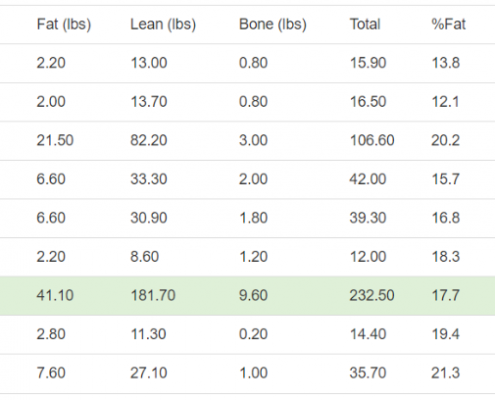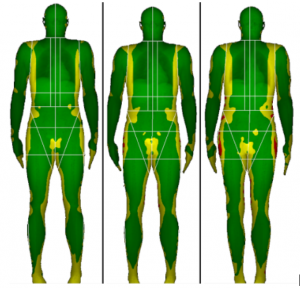Five Reasons For Athletes To Have a DXA Body Composition Scan
Feb 1, 2019
Introduction
Body Composition is breaking the body down into its constituent components, such as fat and lean tissues. Understanding fat and lean tissue amounts can provide an indication of health, fitness, and even athleticism. Observing fat and lean changes over time can provide feedback as to the effectiveness of nutrition and training programs.
Weight and body mass index (BMI) are common methods used in place of measuring actual body composition. They are easy to calculate or measure. Body composition provides significantly more insight into health and fitness.
Body composition offers unique advantages in sports. Effectiveness of changes in nutrition and training can be observed with DXA based body composition. In addition, an athlete’s body may be tuned for a specific sport.
We, at FitTrace, are proponents of Dual-Energy X-Ray Absorptiometry (DXA) based body composition. Some benefits of DXA body composition:
- DXA measures fat, lean and bone tissue masses.
- It captures the distribution of fat, lean and bone in arms, legs, and trunk regions.
- DXA is highly consistent/reliable – medical grade – in its measurements.
- DXA is fast, taking approximately ten minutes.
- It is convenient and comfortable compared to other methods.
- Typically it’s affordable (see Scan Locations on our website for our DXA partners).
- DXA produces a color image which is easy to read and understand.
Figure 1: Data produced by a DXA body composition scan
Due to its highly consistent and reliable measurements, DXA technology has been used in the research community for clinical and medical trials. As a result, there is a great deal of scientific data available supporting the use of DXA for assessing body composition. At FitTrace, we incorporate this data into our app.
DXA has also been adopted in athletics. Professional sports teams in the NFL, NBA, NHL, and soccer utilize DXA. DXA is also increasingly used in college athletics (Ohio State, Florida State, USC, etc.). Olympic teams use DXA too.
Figure 2: Images produced by DXA. This sequence shows three DXA scans taken over time depicting change in body composition. Green indicates low fat, yellow indicates medium fat, and red indicates high fat.
Five Reasons To Have a DXA Body Composition Scan
Reason #1: Understand your body composition
A single DXA measurement has value by itself. It provides an overview into one’s overall level of fitness from a body composition point of view.
Reason #2: Set a baseline in case of injury
An injury may result in temporary changes in one’s body composition. Knowing initial body composition values establishes a baseline that can be used for comparison as one recovers. For example, a knee injury may result in muscle atrophy in the injured. A baseline scan can be used to make sure lean mass returns to pre-injury level and possibly even avoid re-injury.
Reason #3: Measure Effectiveness of Training
Multiple body composition measurements can help understand how training is affecting the body.
- The effect of nutritional changes, such as a diet, can be observed via changes in body composition. Is that diet working as intended? Is fat mass being lost as opposed to lean mass? Is the body being tuned properly for the intended activity?
- Just as with a diet, a good way to measure effects of a new exercise program is by observing changes in lean and fat throughout the body with a DXA scan.
Reason #4: Athletic Optimizing
Body types and composition vary with activity and sports. Long distance runners have different body composition than weight lifters. Body composition may be optimized for a sport using reference data.
Reason #5: Motivation
Athletes are competitive by nature and body composition can help motivate with dietary and training compliance. Athletes can monitor and compare their progress. In addition, amateur athletes may be motivated by comparing themselves with reference athletes or real professionals.
Conclusions
Body composition is a key factor in athletic performance and can be optimized for a sport or activity. DXA’s segmental measurements and medical grade accuracy are an excellent tool for competitive athletics. As DXA use increases in sports to achieve optimal performance and prevent injury, the importance of body composition will also increase.
Related
Video: How to Use Fitbit With FitTrace
Blog: How to Use FitTrace for Health, Fitness, and Weight Loss


